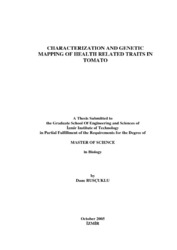Please use this identifier to cite or link to this item:
https://hdl.handle.net/11147/3261Full metadata record
| DC Field | Value | Language |
|---|---|---|
| dc.contributor.advisor | Doğanlar, Sami | - |
| dc.contributor.author | Rusçuklu, Dane | - |
| dc.date.accessioned | 2014-07-22T13:51:12Z | - |
| dc.date.available | 2014-07-22T13:51:12Z | - |
| dc.date.issued | 2005 | - |
| dc.identifier.uri | http://hdl.handle.net/11147/3261 | - |
| dc.description | Thesis(Master)--İzmir Institute of Technology, Biology, İzmir, 2005 | en_US |
| dc.description | Includes bibliographical references | en_US |
| dc.description | Text in English; Abstract: Turkish and English | en_US |
| dc.description | ix, 51 leaves | en_US |
| dc.description.abstract | Tomato is consumed in the daily diet and has a diverse nutritional content including antioxidants, lycopene, vitamin C and phenolics. However, the content of these compounds in tomato cultivars could be higher. There are two ways of increasing the nutritional quality of tomato. One of them is a transgenic way which is still questioned and is not approved in many countries. The other way is molecular breeding which is based on introgression of wild genes into cultivated tomatoes via the combination of classical breeding with molecular marker analysis. This method lets us obtain nontransgenic tomatoes with increased nutritional quality. In this project a population that was obtained from a cross between wild type L.pimpinellifolium and cultivated tomato L.esculentum was used. This population includes 145 inbred backcross lines (IBLs). It was expected that some individuals of this population had increased nutritional quality derived from the wild parent. In order to test this hypothesis, antioxidant activity of each line was measured. The method used to measure antioxidant activity was based on spectrophotometric measurement which gave mol Trolox equivalent antioxidant activity. It was observed that the IBLs were phenotypically close to L.esculentum and that some individuals did have higher antioxidant activity than the cultivated parent. The population was also mapped with molecular markers and 31 possible QTLs which control antioxidants in tomato were found. The source of alleles associated with increased antioxidant characters was usually L.pimpinellifolium. This result confirmed that wild type tomatoes can be a resource for increasing nutritional quality of tomatoes. | en_US |
| dc.language.iso | en | en_US |
| dc.publisher | İzmir Institute of Technology | en_US |
| dc.rights | info:eu-repo/semantics/openAccess | en_US |
| dc.subject.lcc | SB349 .R94 2005 | en |
| dc.subject.lcsh | Tomatoes--Genetics | en |
| dc.subject.lcsh | Agricultural genome mapping | en |
| dc.subject.lcsh | Antioxidants | en |
| dc.title | Characterization and Genetic Mapping of Health Related Traits in Tomato | en_US |
| dc.type | Master Thesis | en_US |
| dc.institutionauthor | Rusçuklu, Dane | - |
| dc.department | Thesis (Master)--İzmir Institute of Technology, Molecular Biology and Genetics | en_US |
| dc.relation.publicationcategory | Tez | en_US |
| dc.identifier.wosquality | N/A | - |
| dc.identifier.scopusquality | N/A | - |
| item.openairecristype | http://purl.org/coar/resource_type/c_18cf | - |
| item.languageiso639-1 | en | - |
| item.openairetype | Master Thesis | - |
| item.grantfulltext | open | - |
| item.fulltext | With Fulltext | - |
| item.cerifentitytype | Publications | - |
| Appears in Collections: | Master Degree / Yüksek Lisans Tezleri | |
Files in This Item:
| File | Description | Size | Format | |
|---|---|---|---|---|
| T000401.pdf | MasterThesis | 395 kB | Adobe PDF |  View/Open |
CORE Recommender
Page view(s)
344
checked on Mar 31, 2025
Download(s)
154
checked on Mar 31, 2025
Google ScholarTM
Check
Items in GCRIS Repository are protected by copyright, with all rights reserved, unless otherwise indicated.